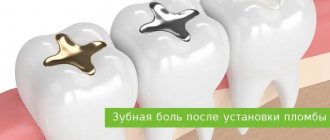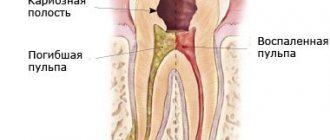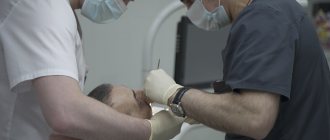Causes Possible complications What to do about pain?
How to relieve pain? Prevention The vitality of a tooth, in particular its sensitivity, is ensured by the neurovascular bundle (pulp). Removal of the pulp (depulpation) is a forced measure, which is resorted to for serious indications (pulpitis, hilar cyst, damage to the pulp chamber due to trauma, etc.). Painful discomfort for several days after depulpation is a normal tissue reaction to the intervention. But if a tooth hurts after removing the nerve and filling the canals 2-3 weeks later
or pain occurs suddenly long after endodontic treatment, this is a good reason to see a dentist.
Even treated teeth should be examined every year to diagnose or rule out complications at an early stage. A pulpless tooth does not hurt, but it is like a time bomb. Poor-quality canal treatment can provoke complications that destroy the jaw bone and cause purulent processes (cysts, abscesses) that are life-threatening. Properly treated canals are the foundation of any restoration. The more modern and high-quality the materials used for their processing, the less likely there are complications.
Can a tooth hurt after nerve removal?
A tooth from which the nerve has been removed is called “dead.” According to logic, a tooth without a nerve cannot hurt. But tissues need time to recover after endodontic treatment. Therefore, reactive pain after dental treatment can normally persist for several days. Over time, it weakens and goes away on its own. Painful sensations usually occur when pressure is applied or while eating - they can last 1-3 days
,
a week maximum
.
The picture is completely different when the pain increases, becomes throbbing, the gums are swollen, red, swollen, and symptoms of intoxication appear - headache, fever, weakness. Such symptoms indicate the development of complications and require immediate attention to the dentist. The doctor will determine why the dead tooth hurts and provide effective treatment.
How to survive nerve removal - step-by-step instructions
Here is a short step-by-step instruction on how to prepare for dental nerve removal and what to do after the operation.
Step one. First, find out why it is necessary to remove the nerve. Decaying nerve tissue allows bacteria to multiply. This is fraught not only with infection, but also with swelling that can spread to the neck, face, loss of bone around the tip of the root, and drainage problems beyond the latter.
Find out the reason for dental pulp removal
Step two. Find out if this procedure is really necessary. The fact is that in some cases not all symptoms of the problem appear.
Determine if you need to undergo a nerve removal procedure
Step three. Visit your dentist. Removing a dental nerve requires one or even several trips to the dental clinic.
Go to the dentist
Step four. Familiarize yourself with the depulpation process, which includes:
- X-ray;
- local anesthesia;
- placing a rubber plate in the mouth to control salivation;
- drilling a hole to access the dental nerve;
- root canal cleaning;
- filling;
- restoration (for protection, for example, a crown can be installed).
Familiarize yourself with the nerve removal or depulpation procedure
Step five. Study the consequences of the procedure. The tooth may hurt for two or three days, but you should not chew hard food on the affected side. To reduce discomfort, you can use over-the-counter pain relievers.
- Frequent urination or why do I pee so often?
Learn about the consequences of nerve removal
If you have questions or comments, write. Also, do not forget to subscribe to site news. I wish you to solve all your dental problems as quickly as possible and not think about them again.
Reasons why a tooth without a nerve hurts
- Re-infection
- not all affected tissues were removed, the source of infection remained, and the inflammation began to spread again. This can happen if endodontic treatment is performed without a dental microscope or if the dental canals have a very complex structure, which does not allow for high-quality cleaning and disinfection. - Poor-quality filling
- when filling the canal, there are voids left in the canal, areas not filled with material, in which pathogenic microorganisms begin to multiply, which leads to inflammation, the development of periodontitis, the formation of cysts, granulomas. - The exit of the filling masses
beyond the root apex - the filling material, having exited through the apical foramen, hardens in the periodontal tissues, compresses the nerve endings, and disrupts blood circulation. Inflammation develops in the periodontium, accompanied by severe pain. - Perforation of the canal walls
– in the area of perforation, the dental tissue becomes infected and inflamed; during filling, the composite may escape beyond the boundaries of the canal. - Incomplete depulpation - due to the complex structure of the canals, the doctor was unable to remove one of the nerve endings. The use of a dental microscope with good optics significantly improves access to the prepared cavity and facilitates the detection of the canal orifices and all nerve branches.
- A fragment of an instrument
in the canal - during expansion, cleaning, filling, a piece of the instrument could break off and remain in the dental canal. The presence of a foreign object contributes to the formation of voids, where conditions are created for the proliferation of bacteria and the development of inflammation. - An allergy
to filling materials or a drug is accompanied by pain, swelling, and discomfort in the area of the dental unit. - A filling that is too high
– the opposite tooth (antagonist) puts excessive pressure on the filling, which leads to the appearance of pain. - Damage to the adjacent unit
- pain spreads (radiates) along the gum from the adjacent tooth.
Why does a tooth hurt when pressed?
If the tooth does not bother you until you start chewing or pressing on it, most likely the reason lies in problems with the ligaments that “attach” the tooth to the jawbone, or due to slight swelling that will subside in a few days.
However, there are other reasons:
- A fragment of a dental needle remained in the canal.
- Excess filling material has gone beyond the root of the tooth and landed on the jaw bone.
- The nerve was not completely removed (in this case the tooth hurts even with light tapping).
- During the treatment of caries, an infection got into the root canals.
If you feel a sharp pain when pressing, it hurts to chew and even speak, you must urgently go to the clinic, take an x-ray and repeat the operation to clean and fill the canals, having previously eliminated possible foci of inflammation.
We correct other people's mistakes. Dental retreatment with a 10% discount
Moscow
Possible complications
- Periodontitis;
- formation of granuloma, hilar cyst;
- periostitis (flux);
- complete destruction and/or loss of the tooth;
- osteomyelitis.
To exclude complications associated with poor-quality endodontic treatment, control radiography is performed at the RUTT clinic in Moscow, and an apex locator is used to assess the depth of the canals. The use of computed tomography and an operating microscope provide more opportunities for accurate diagnosis and quality treatment.
What can hurt after filling?
The pain associated with the installation of a filling directly depends on the structure of the tooth. It consists of a crown, neck and root. On top, all these structures are covered with hard dental tissues that do not have nerve endings. In the crown area it is dentin and enamel, in the root area it is cement. Inside, under the hard covering in the crown area, there is a dental cavity filled with pulp - a pulp that has many nerve endings and blood vessels. The cavity is connected to root canals, also filled with pulp. In the area of the apex (apex), the root is connected to the bone tissue of the jaw using a ligament - the periodontal ligament, which has excellent innervation.
Conclusion: a tooth can only hurt if the pulp and periodontium are diseased or injured during filling.
Canal cleaning and filling
The most common cause is caries - a pathological process accompanied by the destruction of hard dental tissues. This opens access to the dental cavity, root canals and periodontal tissue, inflammation or irritation of which causes severe pain.
Preparing a tooth for filling
Filling is a method of treating caries, but this process itself can cause mechanical irritation of soft tissues, accompanied by pain. Minor pain may be normal, but sometimes you cannot do without the help of a specialist.
In the superficial and middle stages of caries, the affected hard tissues are removed and a filling is placed on top, restoring the shape of the tooth. The dental cavity remains closed. This treatment is absolutely painless and does not require anesthesia. An even more effective way is to have your teeth professionally cleaned to remove plaque and tartar. Regular implementation of this procedure prevents the development of caries and allows you to keep all your teeth healthy for a long time.
Tooth preparation and depulpation
With deep caries, a hole forms in the hard tissues and an infection enters the dental cavity, causing intense pain. In such cases, before filling, preparation is carried out to remove damaged hard tissues and expand the cavity. If necessary, the old filling is also removed. Then the pulp is removed (depulping).
This is a painful procedure, but modern local anesthetics used in dentistry allow the patient to experience no pain at all. If deep caries has developed not so long ago, and the periodontal tissues are healthy, then it is possible to remove only the pulp from the dental cavity (amputation), after which a therapeutic lining is applied and a temporary filling is installed. If there is no pain, a permanent filling is placed after a few days.
In case of long-standing caries, the pulp is first completely removed from the dental cavity, and then from the root canals (extirpation). At the same time, the cost of filling increases.
It is very important to carefully remove the pulp (patients often call it the nerve) from the canal, making sure that no particles of destroyed hard tooth tissue remain in it. All this can support a long-term inflammatory process.
If a tooth hurts after canal filling, the infection can gradually reach the root apex, causing an inflammatory process in the periodontium, accompanied by fever and pain.
What to do if a pulpless tooth hurts?
Soreness after depulpation is a normal tissue response to the intervention. But such symptoms should subside within a couple of days after endodontic treatment. If the canal of a tooth without a nerve hurts and the pain does not subside, but rather increases, you need to consult a dentist. The pain can be different - pressing, aching, throbbing, radiating to the eye socket, temple, cheek. In addition to pain, redness and swelling may occur. An allergy to a material or an antiseptic drug is usually accompanied by a burning sensation, fever, general weakness, and a feeling that the tooth “rises” above neighboring units.
The deeper the pathological process goes, the more pronounced the symptoms. As soon as the inflammation spreads to the periodontium, a person begins to feel pain when biting or pressing on a tooth. When pus accumulates on the gum, a fistula is formed, through which the outflow of purulent contents is ensured, temporarily alleviating the condition. The presence of a fistula is a direct indicator that there is a problem with the roots of the tooth.
The doctor will conduct a diagnosis and determine the exact cause of the pain. To do this, an examination is carried out and a number of x-ray studies are performed:
- targeted photographs of the affected tooth in different projections;
- orthopantomogram;
- 3D tomography.
The doctor selects therapeutic tactics according to the clinical picture. If the pain occurs due to re-infection, an allergy to the material, or errors in the initial treatment, re-treatment is carried out - the root canals are opened, processed and filled. If the pain is caused by pulpitis or deep caries of an adjacent dental unit, treat it. Cysts, flux, osteomyelitis are treated surgically - the gums are cut, cleaned, and the affected areas are removed along with part of the tooth root (according to indications). If it is not practical to save a tooth, it is removed followed by prosthetics.
What complications may arise?
Pain is one of our body's defense mechanisms. If there is pain, it means one of the systems is not working correctly, and there is a certain pathology. If you do not pay attention to these signals for help in time, you may encounter serious complications:
- Inflammation under the tooth
. At first it will be concentrated in one place. But in the absence of proper treatment, it will spread to nearby tissues, and then, through the bloodstream, throughout the body. - Infection of adjacent teeth
. If the cause of the pain is the proliferation of pathogenic bacteria, it is likely that the infection will spread to the soft tissue of the gums and then spread throughout the entire oral cavity.
If, after removing a nerve, a wisdom tooth hurts, then, contrary to popular belief, it is not necessary to remove it - if it is possible to repeat the treatment, eliminating the source of infection and inflammation, the doctor will definitely do everything in his power to save the tooth.
In the most advanced cases, the doctor usually decides to remove the filled tooth.
How to relieve pain
If a tooth hurts severely after treatment of pulpitis, taking a pain reliever (Analgin, Ibuprofen, Ketolac, etc.), rinsing the mouth with an antiseptic solution or a warm herbal decoction of lemon balm, sage, oak bark, chamomile, will help temporarily relieve the pain symptom and alleviate the condition. calendula.
It is strictly forbidden to heat a sore tooth, apply alcohol or garlic compresses to the gums, or take antibiotics or aspirin.
Post-filling pain
If a tooth hurts after nerve removal and filling, this should not immediately become a cause for panic, especially when only a few hours have passed since visiting the dentist. The procedure for removing a nerve goes like this: first, the doctor injects an anesthetic into the gum, then opens the diseased tooth with a drill, removes the nerve, then cleans the root canals and installs a suitable filling.
Should the tooth hurt during this procedure and after it, many patients ask. During the manipulation, a person will not feel pain, since modern anesthetics act gently, providing complete comfort. But if after the procedure the gums hurt, they are swollen, and the newly treated molar aches with it - this is a consequence of the dentist’s extensive work.
If the carious process was complicated by pulpitis, microtrauma to the tooth tissue is inevitable, because the nerve endings are intertwined into a single bundle. It is responsible for the sensitivity of the teeth, facial muscles and jaw, so after serious manipulation, pain of this kind is considered natural.
The following symptoms are observed in this condition:
- the tooth reacts to hot, sour, cold, spicy, as well as to sweet drinks and air at unusual temperatures;
- pain when biting hard food and when tapping on a tooth;
- sharp unpleasant sensations in the gums and tooth tissues, aching or pulling, that occur in the evening and daytime;
- discomfort during tightly closing the mouth and closing the jaws.
In addition to the increased sensitivity of the molar and hyperreaction to food, a person may experience headaches, weakness and malaise in the first 1–2 days. After two days, such signs should completely disappear, which will indicate that the nerve was removed correctly and subsequent filling was performed.
Diseases that often provoke dental problems, even after quality treatment
If the pain in the tooth persists for a long time (at least 7 days), and this symptom is accompanied by a rise in temperature, inflammation of the gums, discharge of pus and a sharp deterioration in health, you should not delay a visit to the doctor, complications in the form of gumboil and purulent lesions of the gums are possible, it's called gingivitis.
How does a postoperative wound heal?
How long the area hurts after tooth extraction depends on many factors. The healing process after tooth extraction is a complex and lengthy process. Removal occurs with a rupture of the dentofacial connection, namely the connection with the alveolar process and the jaw bone.
The recovery process lasts about two to three weeks. Much depends on the surgical protocol, the clinical situation and the characteristics of the body.
Main stages:
- Formation of a blood clot. Forms 1.5-3 hours after extraction. The function of the clot is to protect the wound area from pathogens and secondary infection.
- Active tissue regeneration. The affected mucous membranes are restored, after 3-4 days swelling and inflammation decrease.
- Formation of granulation tissue. After 4-6 days, granulation tissue forms on top of the clot - the basis of a new epithelial layer.
- Granulation proliferation. After a week, the granulation tissue grows, completely covering the socket.
Already on the eighth to tenth day, the wound is completely healed and by the end of the second week a new epithelial layer is formed.
After two weeks, bone tissue begins to renew. After six months, the bone tissue in the area of removal becomes completely healthy.
Prevention
The risk of tooth pain after a filling is installed can be reduced if you follow all the dentist’s recommendations for oral care.
What not to do before filling
When planning a visit to the dentist, you need to:
- choose the most suitable time so that you can rest after the filling is placed;
- eat, as you will not be able to eat immediately after treatment;
- Do not drink alcoholic beverages under any circumstances, as they may have undesirable reactions with the painkillers used during treatment;
- Brush your teeth thoroughly and rinse your mouth with an antiseptic solution, such as mouthwash.
You should not plan to place a filling during any acute illness or exacerbation of some chronic disease.
What not to do after filling
It is important to adhere to the following tips:
- do not eat or drink for two hours;
- try to avoid chewing on the affected side of solid food;
- do not eat too hot or cold food for 5 – 7 days;
- avoid coloring products that can change the color of the filling material (beets, red wine, etc.);
- brush your teeth only with a new soft toothbrush twice a day;
- use an alcohol-free mouth rinse;
- do not use dental floss to remove food debris; it is better to replace them with a new product - an irrigator.
Treatment at home
Without the help of a specialist, symptomatic therapy can be carried out using pharmaceutical medications and traditional methods of therapy.
Important to remember! Home treatment can only relieve pain when pressed for a short period of time. To completely get rid of a symptom, you need to eliminate the cause of its occurrence.
Medicines
When treating toothache after depulpation, the following drugs are used:
- You need to take medications in accordance with the dosages indicated in the instructions, unless there are contraindications.
Ketanov;
- Paracetamol;
- Analgin;
- Ibuprofen;
- Spasmalgon;
- Solpadeine.
The listed painkillers are available in the form of tablets for oral administration.
You need to take medications in accordance with the dosages indicated in the instructions, unless there are contraindications.
For toothache after nerve removal, it is also recommended to use rinses. These include the drugs Stomatofit, Tantum Verde, Chlorhexidine, Angilex.
Traditional methods
To treat toothaches, it is recommended to use the following methods:
- Rinse with Novocaine. To prepare, mix 200 ml of Novocaine solution (1%), 1 spoon of salt, 1 egg white. Rinse your mouth with the resulting mixture for 5-10 minutes. The product relieves pain and relieves the patient from discomfort.
- Wine with herbs. Add 200 ml of wine and 0.5 cups of dried herbs sage and rosemary to the container. The liquid is boiled for 3 minutes, then cooled and a spoonful of honey is added. The finished medicine is used for rinsing 3 times a day after meals.
- Ice compress. Wrap a few ice cubes in a napkin and place them on your cheek in the area of the sore tooth. Due to the effects of cold, pain sensitivity is reduced and swelling is eliminated.
- Chamomile decoction. Add 5 tablespoons of dried chamomile flowers to 1 glass of boiling water. The liquid is boiled in a steam bath for 30 minutes, after which it cools. A warm mouth rinse is used several times a day.
- Salt rinse. To prepare, add 0.5 tablespoons of salt and soda to 1 glass of warm water and mix. You need to repeat rinsing once every 2 hours.
Self-medication can reduce the intensity of pain, but we must not forget about the need to visit a doctor if the pain intensifies or lasts longer than 10 days.
Pain during difficult removal
The duration of pain after complex extraction (wisdom teeth, impacted or dystopic incisors) is associated with damage to a larger tissue area. Often such an operation involves making an incision in the gum, sawing out the roots, extracting tooth fragments, and draining an abscess, which increases the scope of the surgical intervention. If your ear hurts after wisdom tooth removal, this may indicate nerve damage.
In some cases, patients complain of persistent discomfort and pain for up to a week. Clinical manifestations such as swelling, swelling of the gums, enlarged submandibular lymph nodes, fever, and malaise are also common.
Causes of pain
The occurrence of pain after tooth extraction is associated with damage to nerve endings, vascular structures and soft tissues. The peak intensity of pain occurs in the first hours after the cessation of anesthesia. The symptom persists for about 12 hours.
In case of incisions in the gums or damage to the bone tissue, as well as after implantation after removal, toothache may persist for 2-3 days. Pain syndrome also occurs in the case of displacement of the dentition towards the formed void. Therefore, doctors recommend prosthetics as soon as possible after extraction.
What to do if a tooth hurts under a filling, in which there is no nerve, but sensitivity remains
With persistent pain and progressive sensations, the only right decision is to consult a doctor. Only he can remove the pulp completely, even if the nerve endings were left behind, and also determine an additional cause for the symptoms.
Emergency methods of control
If it is not possible to urgently go to the dentist, then it is quite possible to relieve the pain caused by the inflamed nerve residue. To do this, it is enough to drink a strong painkiller or use traditional methods - rinses, lotions. Note that medications need to be dosed, and their compatibility with other drugs must be monitored.
And most importantly, you need to understand that these are only temporary measures that are needed to hold out until the moment when a doctor sees you and provides assistance.
Using medications at home
Even after proper treatment in the dental office, pain is a normal reaction due to irritation of the gums, as well as aching enlarged canals and neighboring teeth. But no one wants to live with constant pain for 7-10 days, so immediately after leaving anesthesia it is recommended to take drugs such as Analgin, Ibuprofen; Ketorol and its analogues are considered the most effective. This will not only remove the symptoms, but also stop the inflammatory process and relieve swelling. You cannot take pills every day. Therefore, if symptoms increase, you should immediately make an appointment with a doctor.











